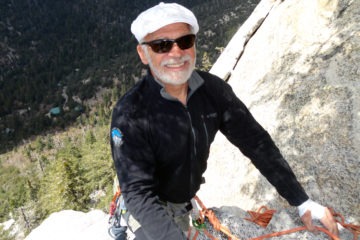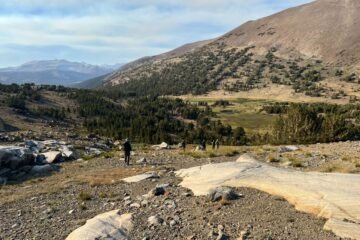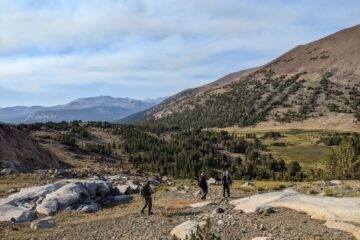Kaleb Goff (above, in Yosemite’s high country), grew up in San Diego County, where the suburban canyons, ocean shore and low-lying mountains shaped his love for wild spaces. As a naturalist and guide, he draws on his passion for the outdoors to help people connect with nature.
In this guest post, Kaleb, who leads Outdoor Adventures for the Conservancy, offers insights about observing animals — and reconnecting with wild life — in Yosemite.
Jackrabbit,
black-tailed Hare
by the side of the road,
hop, stop.
Great ears shining,
you know me
a little. A lot more than I
know you.
— Gary Snyder, “Jackrabbit”
I keep poems taped to the dashboard of my car, and the books scattered over the seats and spilling onto the floor. I chant them on the way to walks, talks, explorations and forays, to freshen the air. Not to change the scent of my dirty climbing shoes, but to kindle memory. To remember the soft squirrel tracks in new snow, to remember to check for spider silk across the trail, to remember the excitement of finding butterfly eggs under new orchid leaves, to remember my privilege of living and working in Yosemite National Park.
The world is wild. Here in Yosemite, there are over 400 species of vertebrates (fish, amphibians, birds, reptiles and mammals), which we commonly refer to as wildlife. Over a quarter of North America’s nearly 1,000 bird species have been seen inside the park. More than 80 mammal species make their homes here, including eight different chipmunks and 17 bat species, a creature so rare we can almost be sure we will never see it in the flesh in our lifetimes (Sierra Nevada red fox), and the wonderfully reliable black-tailed mule deer.
This is to say nothing of the currently unknown number of invertebrates in Yosemite, which is bound to be a staggering number, considering that one can see upwards of 70 species of butterflies around Tuolumne Meadows on a single sunny summer day.
Each of these species has its own set of tracks, as well as a unique name, habitat, behavior, web of connections and mysteries. For context, consider the diversity of people in your contact list or among your social media “friends.” The diversity among them is likely very large, and you probably know very few of them very well and almost nothing about the others. This is just within our relatively homogeneous human species! Now expand that idea out to the number of unique species in Yosemite!
As naturalists, lovers of wildness, adventurers and explorers, what can we do with this staggering diversity? How can we make more discoveries? How can we live with more wonder, more wildness, more trust and caring?
For me, this long trail of discovery begins in memory, with an openness to notice what reveals itself to me. As a naturalist, I go where I want to go. I stop for the first glimmer of wild life that draws me in, and I am happy to stay all day.
![]()
At the time of my writing, spring has not yet come to the lower slopes of Yosemite. Late season rain and snow from the “March mitigation” storms have brought the needed calm of winter. The footprints of animals long passed, known as tracks (not to be confused with tracts, the patches of feathered areas on birds), are the flowers of this time. They bloom most vividly in fine mud and snow, which is luckily one of the most common symptoms of winter and early spring.
Tracks are often our closest encounters with a whole swath of creatures that are only active at night, including mountain lion, fox, raccoon, badger, skunk and porcupine. Crouching in the cold morning air over the fresh tracks of one of these animals, you are gazing into the physical presence of an animal that has long since passed.
![]()
![]() Tracks are perhaps the most accessible type of naturalist observation: They’re less complicated than flowers, and fully willing to endure our scrutiny without running or flying off! In the words of famous tracker Tom Brown, “tracking is like learning to read. First you start with ABCs, then you work up to simple sentences, then to paragraphs and finally books.”
Tracks are perhaps the most accessible type of naturalist observation: They’re less complicated than flowers, and fully willing to endure our scrutiny without running or flying off! In the words of famous tracker Tom Brown, “tracking is like learning to read. First you start with ABCs, then you work up to simple sentences, then to paragraphs and finally books.”
Start in morning, when tracks are likely to be fresh, and fewer tracks of human will be found. Areas along rivers or streams are often the corridors of movement for animals, and contain a mix of substrata (surfaces) that give a highly detailed log of animal movements. Please note that these are also some of the most fragile places, and you will do significant harm there if you act with anything but the highest sensitivity.
Tracks are a wonderful subject for field journaling. When you find your first few tracks, make notes of the shape, length, width. You might also note what is missing from a track, count the number of toes, the presence or absence of claw marks, and the shape of the footpads. If you are taking a photo of a track, make sure to place something with a known size next to the tracks for scale. The one-hundred track challenge is a fantastic way to spend an afternoon tracking. The challenge is simple yet brilliant: Find one hundred tracks in a row. Ready? Go!
![]() Another simple exercise for beginning to notice animal tracks is to track in reverse. You can track in reverse by watching an animal respectfully, giving it the space it needs to move on, and then going in and finding the tracks you watched it make! Bobcats, a relatively common sight in Yosemite Valley during morning and evening, are a great creature to track in reverse. They’ll also give you practice with cat tracks, which can help you build the skills you need to find one of the most sought after tracks, the mountain lion.
Another simple exercise for beginning to notice animal tracks is to track in reverse. You can track in reverse by watching an animal respectfully, giving it the space it needs to move on, and then going in and finding the tracks you watched it make! Bobcats, a relatively common sight in Yosemite Valley during morning and evening, are a great creature to track in reverse. They’ll also give you practice with cat tracks, which can help you build the skills you need to find one of the most sought after tracks, the mountain lion.
Tracking allows us to glimpse into the wild lives of animals, and thus imbues us with great responsibility. We are given the gift of being able to enter animals’ lives directly, to note their patterns and to conjure their presence long (or soon) after they have moved on. Remember that we owe a great deal to wild animals for these gifts; and beyond that, as the original peoples of the lands we visit, they have intrinsic and important rights. Tread lightly. Be quiet, and show respect by never disturbing an animal’s pathways, homes or feeding grounds. Remember that you are nothing but another predator. Keep a distance of at least 75 meters (~250 feet) to avoid putting pressure on an animal’s energy reserves.
Wildlife has always been a tricky term for me. As a single word, the noun neutralizes the flair of its conjoined adjective, wild, one of our most heart-wrenching, hopeful, holy four-letter incantations. Giving each four-letter segment space to stand on its own — wild life — makes me much more comfortable.
The opportunity for a wild life is endless, and inevitably just out of reach. If you’re reading these words, you probably understand the trade-off you are making with wildness. We often see the wild earth through screens, dream from desks of quiet days outdoors, tick off to-do lists while wishing for wild unstructured time.
The only antidote I can find is memory, remembering our wild lives and the wild lives we share the world with. The memory of the smell of sun on granite, of being struck by the first orange-crowned warbler song of spring, of the coldness of wind on your sweat.
Perhaps the memories are awakened by poetry, but more likely poetry is awakened by place. Any place will do, but some of our memories are deeper, a whole lot deeper, and a wilder place is needed to wake them.
For many, Yosemite is that place. Come walk with us, in any sort of weather, and we will try tracking down our remembrance together.
![]()
Thanks for reading! Take a few minutes to explore our website, where you can browse upcoming opportunities to walk with (and learn from) Kaleb and our other naturalists in Yosemite, and find out how your gifts help protect diverse animal species.
Photos courtesy of Kaleb Goff, unless otherwise noted.



